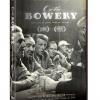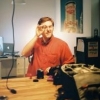Search the Community
Showing results for tags 'overhead'.
-
I'm shooting a music video inside a restaurant with drop ceiling (location) and would like to create practical overhead lighting (like this) to give us more freedom with our framing. In the example above -- it looks like they popped out tiles where they needed light, laid out a large cut of diffusion across several tiles and placed individual fluorescent tubes (astera, quasar or kino?) on each rectangle. What do you think? Can anyone provide any helpful ideas on how to achieve lighting like this on a modest budget? The restaurant also has several 3-bank T12 fluorescent fixtures already installed. I'd like to replace these fixtures with T12 kino tubes but the location is pretty dated and I'm worried about flickering because of old ballasts. How can I tell if the ballast will produce a flicker? I looked around the fixture and didn't find any specs printed on the side.
- 5 replies
-
- drop ceiling
- drop
- (and 14 more)
-
Hey everybody, I have a short film shoot coming up soon that's becoming quite a challenge. I've attached a rough floor plan for reference. Hopefully, soon I'll be able to go in and get actual measurements of the room. Basically, the scene is about a couple in their bedroom at night. The director wants a warm, somewhat dim look. The scene from Sicario when Jon Bernthal's character attacks Emily Blunt comes to mind, though far less of a silhouette. We'll be doing some tests later this week and possibly rearranging some furniture, but this is what I know so far: The scene must be done in one continuous take, meaning I will have to follow the actors as they move around the room from the vantage point of the camera near the corner. At various times throughout the scene, the actors will need to be at the mirror, the closet (it's a long closet with sliding doors. I'll be getting a profile shot of one of the actors looking into it at the spot I currently have them pictured at here), and going out into the hallway. With so much of the room being shot, and with the room being fairly cramped, I'm very worried about how I'm going to be able to light it and yet still manage to hide everything from the camera. My current idea is to rig up a wall spreader with two diffused lights (I'm thinking two 420w Peppers) aimed in the direction of my actors to imitate the glow of the lamps behind them. Then I'll set up a light in the closet to provide a little bit of fill, thus suggesting another practical source within the closet, but I'm honestly not sure how good this will look, hence why I'm planning to do some tests later this week. I feel like this is going to be pretty challenging, so I'd be very thankful to hear whatever thoughts or advice you guys might have.
-
Hi guys, I wanted to find out what techniques people are using to combat/harness overhead light. I've got a scene coming up where there's a bunch of fluorescent fixtures in the ceiling (the only motivation for light in the location) so I'd like to use it as the main source but keep it fairly low-key with nice shaping to the faces. In my previous experience I've found it difficult to achieve a flattering look on the talent (such as the attached image from Skyfall - which works well for the scene but is what I'm trying to avoid). Are there any techniques you employ in your own work to avoid overly shadowy eyes? I thought Rodrigo Prieto's work in Wolf of Wall Street (image attached) was really well handled as there's a nice shaping of light on the faces in what would otherwise be quite a flat looking environment with banks of fluorescents in the ceiling of an office - would he have employed additional lamps from lower angles in conjunction with the practical lights in the ceiling to create a pleasing lighting contrast to the faces? There are a few ideas I've already experimented with such as softening the overhead light with diffusion - which I like but, again, still gives pools of shadow under the eyes. Bouncing the light from below with reflectors softens the contrast of overhead lighting but always feels like an additional source coming from an angle which doesn't feel natural? Maybe I need to be more subtle.. What techniques do you recommend/use in every day situations? I'd be interested to hear advice for all manner of situations (low key, high key, dramatic, experimental, etc). I love Robert Richardson's top-light look but I'd like to avoid this style in favour of a softer, more natural feel for my upcoming project. Thanks in advance! - James.
-
Hello everyone, I need your help. I'm currently a film school student. I will direct a very short film/exercise (one day of prep one day of shooting) in 40 days. So the mood and the set design will be a weird mix between Kubrick films (2001, Clockwork..) and THX 1138, kinda. Anyway we have this 4 by 10 meters set at school, that has no ceiling. But I have one obligation for this exercice/short : only use a 16mm lens (on the Alexa). 10 meter long room, 16mm.. I'd better need something as a ceiling. I'd want something white I could use as a diffusion so that the ceiling would be a giant soft source. So I have two questions for you experienced people : What would you consider for the ceiling (doesn't have to be realistic at all) given a very limited budget. What kind of light could be use above that fake ceiling, to create a high-key look overall (the set will be mostly pure light with some black lines to give some perspective, the costumes black and white as well) (we have tungstenes up to 4K, hmis up to 2.5k I think and kinos) I'll also have some diffused light coming from the walls (I'll remove the windows of the set and place 216 frames instead) Thanks everyone !
-
Looking to do a long truss mounted tracking shot for a show I'm working on in NYC. Can't seem to pinpoint what a system like this is called and where to rent in NYC: http://www.youtube.com/watch?v=iKcBNbRSdyI#t=14 Anybody have any suggestions?





